Brown Woolly Bugger
By Dave Hughes
The largest mayflies fall into the burrowing category. Some reach
two inches long when they're mature, and make quite a mouthful
for any trout. Many, such as the eastern green drake (Ephemera
guttalata) and midwestern and western Hex (Hexagenia
limbata) have two- or three-year life cycles, meaning the
nymphs are out there all year long in one instar or another. Trout
always feed on them when given a chance at them.
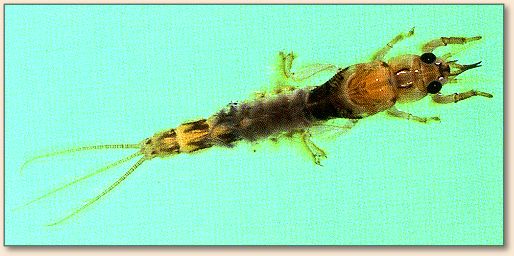
Burrowers, as their name implies, either dig tunnels into mud,
marl, and clay bottoms, or work their way into sand or gravel
bottoms until they're out of sight. They come out to forage
along the bottom only at night, which limits the time they're
available to trout, and also the time that they're useful as
the basis for imitations, to the hours of darkness.
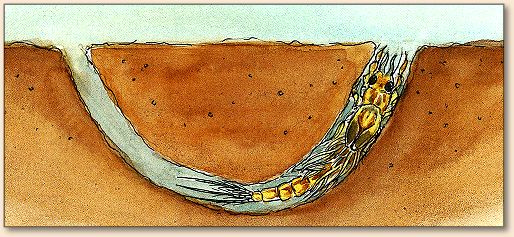
When mature and ready to emerge, burrower nymphs leave their
tunnels or free themselves from the sand and gravel, then swim
boldly to the top, where the nymphal skin splits in the surface
film and the dun escapes. This, like their feeding, usually
happens after dark, though on a gloomy summer afternoon, say a
day with thunderheads lowering and darkening the sky, they
might begin emerging two to three hours before dark.
Though many more imitative dressings have been devised for these
large nymphs, it's difficult to beat a Woolly Bugger in the
appropriate size and color to resemble the natural. The
marabou tail undulates in the water, and represents the swimming
motion of the natural more realistically than the most exact
but lifeless imitation might. With any insect that swims briskly
and emerges in poor light, it's more important to copy the movement
than it is the precise shape.
Materials for the Brown Woolly Bugger:
Hook: 3X long, size 6 - 12.
Weight: 15-20 turns lead wire.
Thread: Brown 6/0.
Tail: Brown marabou with a few strands of red Krystal Flash.
Hackle: Brown hen, palmered over body.
Body: Brown chenille.
Tying Instruction for the Brown Woolly Bugger:
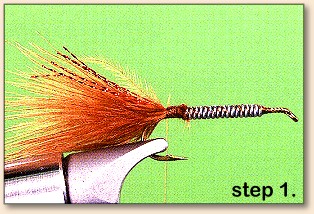
Step 1: Fix hook in vise, layer mid-shank with lead wire, and
layer working thread to the bend. Measure a clump of
marabou the full length of the hook, and tie it in at the
bend of the hook. You can also tie the marabou long,
then pinch it off at the right length. Tie in 4 to 8 strands
of Krystal Flash, just short of the marabou length.
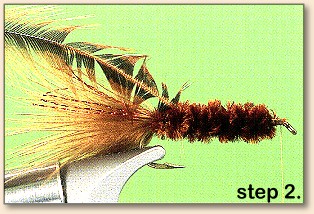
Step 2: Tie in the body chenille at the bend of the hook.
Select a hackle with fibers about two times the hook gap.
Tie it in by the tip, with the concave side against the
body. Leave room for one turn of chenille behind the
hackle tie-in point. Take your thread forward to the
hook eye.
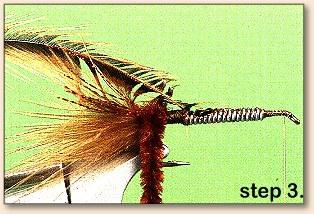
Step 3: Take a turn of chenille behind the hackle, then
wind the body forward in front of the hackle to the hook
eye. Tie it off and chip the excess.
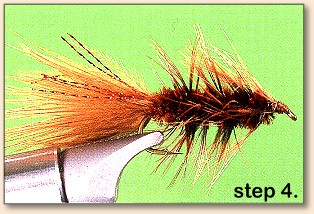
Step 4: Wind the hackle forward in evenly-spaced turns to the
hook eye. The hackle fibers should tend to flare back, not
forward. Tie off the hackle stem, clip the excess, form a
neat thread head, and whip-finish the fly.
I've often set up aquariums with Hexagenia nymphs
and attempted to take photos of them swimming. I always fail
because they are able to move so swiftly. They propel themselves
with an up-and-down undulating motion of the entire body, no
doubt helped along by their fringed gills and tails.
Woolly Buggers, because of their marabou tails, do an
excellent job of imitating the movement. Though other food
forms are not the subject of this book, Woolly Buggers also
move in the water like pollywogs, leeches, damselflies, and some
baitfish, all of which trout enjoy eating when they get the
chance, and all reasons that these flies should have a place in
your fly boxes. I'd recommend you carry them in olive, black
and the listed brown, weighted, on size 6 to 12 hooks.
~ Dave Huges
Credits: The Brown Woolly Bugger is from
Matching Mayflies, by Dave Hughes, published by Frank Amato
Publications, (2001). If you plan on attending the Michigan
Fish-In, you should tie up some of these. ~ DLB
|



